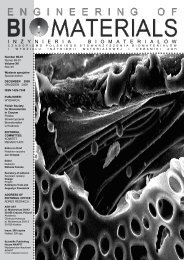69-72 - Polskie Stowarzyszenie BiomateriaÅów
69-72 - Polskie Stowarzyszenie BiomateriaÅów
69-72 - Polskie Stowarzyszenie BiomateriaÅów
You also want an ePaper? Increase the reach of your titles
YUMPU automatically turns print PDFs into web optimized ePapers that Google loves.
112 Materiały i metody<br />
Syntezę PEE i TEEE przeprowadzono dwuetapowo.<br />
W pierwszym etapie, dihydroksy(tereftalan butylenu)<br />
będący składnikiem tworzącym segment sztywny (PBT)<br />
otrzymywany był na drodze transestryfikacji tereftalanu<br />
dimetylu (DMT) i 1,4-butanodiolu (BD) w podwyższonej<br />
temperaturze z dodatkiem katalizatora MiTg. Podczas drugiego<br />
etapu, poli(glikol etylenowy) (PEG1000, PEG4600) i<br />
kwas dilinoleinowy (DLA) będące składnikami segmentów<br />
giętkich dodawano wraz ze stabilizatorem termicznym<br />
(α–tokoferol, witamina E, VE). Polikondensację prowadzono<br />
w temperaturze 250-255°C i w próżni 0.5-0.6mmHg.<br />
Za moment zakończenia procesu uznawano zwiększenie<br />
wartości poboru mocy przez mieszadło w reaktorze świadczące<br />
o zwiększeniu lepkości stopu. Struktura PEE i TEEE<br />
przedstawiona została na Rys.1, a ich skład chemiczny<br />
zestawiono w Tab.1. Jako próbki odniesienia użyte zostały:<br />
komercyjny polilaktyd (PLLA) z dwudziestoprocentowym<br />
dodatkiem skrobi BOR-P-680Z chińskiej firmy GreenPlast<br />
(BR) oraz komercyjna skrobia Bioplast GS 2189 francuskiej<br />
firmy Biotec.<br />
was obtained by transesterification of dimethyl terephthalate<br />
(DMT) and 1,4-butanediol (BD) at elevated temperature in<br />
presence of MgTi catalyst. During the second stage of the<br />
reaction, a poly(ethylene glycol) (PEG1000, PEG4600) and<br />
a hydrogenated dilinoleic acid (DLA), being a components of<br />
soft segments were added along with the thermal stabilizer<br />
(a-tocopherol, vitamin E, VE). The polycondensation was<br />
carried out at 250-255°C and 0.5-0.6mmHg of vacuum.<br />
The process was considered complete on the basis of the<br />
observed power consumption of the stirrer motor when<br />
the product of highest melt viscosity was obtained, up to<br />
a constant value of power consumption by the reactor<br />
stirrer was achieved. The structure of PEE and TEEE is<br />
shown in Fig.1. and their composition is shown in Tab.1.<br />
Commercial polylactide with 20% addition of starch BOR-<br />
P-680Z by GreenPlast, China (BR) and commercial starch<br />
Bioplast GS 2189 by Biotec, France were used as reference<br />
samples.<br />
The polymer fibers were prepared by spinning from the<br />
melt. Dry pellets of materials were charged into the spinning<br />
machine (own construction from the Polymer Institute).<br />
The fibers were prepared at the temperature 10deg higher<br />
as the melting point of a polymer. A single screw<br />
spinning unit with l/d=13,3 and diameter of spinning<br />
nozzle 0,8mm was used. The fibers were stretched<br />
on godets and collected. The diameters of obtained<br />
fibers were measured on lanameter. Their tensile<br />
strength, Young modulus and strain were evaluated<br />
in mechanical tests on Zwick 1435 test machine.<br />
RYS.1a. Struktura chemiczna kopolimeru PEE.<br />
FIG.1a. Chamical structure of copolymer PEE, (DP-degree of<br />
polycondensation of segments).<br />
Results<br />
Diameters of obtained fibers were presented in<br />
table 2. The thickest fibers were made from copolymer<br />
1 (26PEE1000) and terpolymer 2 (26TEEE1000).<br />
RYS.1b. Struktura chemiczna terpolimerów TEEE.<br />
FIG.1b. Chamical structure of TEEE terpolymers, (DP-degree of polycondensation of segments).<br />
Włókna polimerowe formowano metodą przędzenia ze<br />
stopu. Wysuszony materiał dozowano do leja zasypowego<br />
maszyny przędzalniczej (konstrukcja własna Instytutu<br />
Polimerów). Temperatury w strefach grzania były wyższe<br />
o 10 stopni od temperatury topnienia danego polimeru.<br />
Zastosowano ślimak o l/d=13,3, natomiast średnica dyszy<br />
przędzalniczej wynosiła 0,8mm. Odbierane włókna orientowano<br />
i rozciągano na systemie galet.<br />
Zmierzono średnice otrzymanych włókien przy użyciu<br />
lanametru, a następnie na maszynie wytrzymałościowej<br />
Zwick 1345 wyznaczono ich wytrzymałość na rozciąganie,<br />
moduł Younga oraz odkształcenie przy zniszczeniu.<br />
Wyniki i dyskusja<br />
W tabeli 2 przedstawiono średnice otrzymanych<br />
włókien. Najgrubsze włókna uzyskano z kopolimerów 1<br />
(26PEE1000) i 2 (26TEEE1000). Odznaczały się one również<br />
najmniejszą wytrzymałością - poniżej 20 MPa (rys.2),<br />
najniższym modułem Younga w granicach 100 MPa (rys.3)<br />
Their tensile strength and Young modulus were the lowest<br />
(adequately below 20 MPa and about 100MPa) (figs. 2,<br />
3), and elongation was about 300% (fig.4). The second<br />
groups of fibers consisted thicker ones such as starch fribers<br />
(GS) and polylactide fibers modified by starch (BR).<br />
Oznaczenia<br />
Multiblock co- and terpolymers<br />
próbek<br />
PLLA<br />
skrobia<br />
PBT DLA PEG 1000 PEG 4600<br />
Sample code<br />
starch<br />
1 (26PEE 1000 )<br />
– 74% –<br />
2 (26TEEE 1000 ) 15% 59% –<br />
26%<br />
3 (26TEEE 4600 ) 15% – 59%<br />
4 (26PEE 4600 ) – – 74%<br />
6 (45TEEE 1000 )<br />
– – 45%<br />
36% 19% –<br />
7 (45PEE 1000 ) – 55% –<br />
GS – 100% – – – –<br />
BR 80% 20% – – – –<br />
TABELA 1. Skład syntetyzowanych polimerów i<br />
handlowych polimerów resorbowalnych.<br />
TABLE 1. Composition of synthesized materials and<br />
commercial resorbable polymers.













